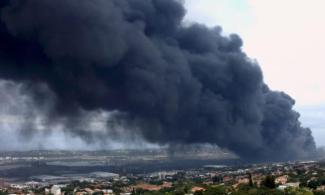
It stated that air pollution has vast consequences for public health in Africa, hence, the report identified major polluters and air pollution sources across the continent.
A report by an environmental non-governmental organisation, Greenpeace, has revealed that Nigeria, South Africa and Egypt suffer the highest levels of air pollution in Africa.
According to the report, the high levels of air pollution have propelled the three countries to record most of the continent's nearly one million annual air pollution-related deaths, stressing that "Exposure to air pollution is the second leading risk factor for death in Africa."
Greenpeace said that the report investigated the biggest human-caused air pollution sources in Africa, especially those associated with major industrial and economic sectors and the fossil fuel industry, noting that these emitters often have significant power and by reducing emissions could bring real benefits to affected communities.
It stated that air pollution has vast consequences for public health in Africa, hence, the report identified major polluters and air pollution sources across the continent.
The report highlighted the need for clean, renewable energy, an end to reliance on fossil fuels and combustion for energy and better regulation of air quality and emissions. These steps are critical for the well-being of people living in Africa and for the reduction of environmental injustices.
It stated that “Air pollution in Africa frequently exceeds the levels recommended by the World Health Organisation, posing risks to public health. Poor air quality is a leading risk factor for deaths across Africa. However, many parts of Africa have little or no publicly available air pollution monitoring results.”
According to the report, satellite datasets and databases of emissions can reveal the air pollutants which contribute to air quality problems in Africa, including emissions of nitrogen oxides, sulphur dioxide, non-methane volatile organic compounds and particles including black carbon.
“These pollutants are often closely linked to sectors responsible for significant fuel burning, and all contribute to fine particulate air pollution.”
Greenpeace noted that “Many of the emission hotspots identified align with thermal power plants, cement plants, metal smelters, industrial zones, or urban areas.
“Six of the world's ten largest nitrogen dioxide emission hotspots identified in this analysis were found in Africa, all of these are in South Africa.
“The ten largest nitrogen dioxide point sources identified in Africa are all thermal power stations, nine of which are in South Africa, the tenth is Azito and Vridi CIPREL (Compagnie Ivoirienne de Production d'Electricité) Power Plants in Côte d'Ivoire.
“Two of the world's ten largest sulphur dioxide emission hotspots identified in this analysis were found in Africa, and again, these are both in South Africa.
“Of the ten largest sulphur dioxide point sources identified in Africa, nine are thermal power stations and one is linked to a smelter complex in Mali.
“Four of the power plants are located in South Africa, two each in Morocco and Egypt, and one in Zimbabwe.
“In North Africa, emissions data suggests that the sector contributing most to nitrogen dioxide, volatile organic compounds and sulphur dioxide emissions is the energy sector. Fuel burning at home emits most black carbon.
“In West Africa, the sector contributing most to nitrogen dioxide and black carbon emissions is residential combustion. The energy sector emits most volatile organic compounds and sulphur dioxide emissions and these emissions are closely related to oil and gas infrastructure in Nigeria.
“In East Africa, the sector contributing most to nitrogen dioxide and black carbon emissions is residential combustion, while the energy sector emits most volatile organic compounds and industry contributes most sulphur dioxide emissions.
“In Central Africa, the sector contributing most to nitrogen dioxide, volatile organic compounds and black carbon emissions is residential combustion. Industry contributes most sulphur dioxide emissions.
“Poor air quality in this region has been attributed to waste burning, mining, and industrial practices such as mineral processing and cement manufacturing.
“In Southern Africa, the sector contributing most to nitrogen dioxide, volatile organic compounds and sulphur dioxide emissions is the energy sector, whereas residential combustion contributes most black carbon emissions.
“Coal makes a very large contribution to fine particulate matter pollution. Waste burning is, both in residences and at dumps, an important factor contributing to black carbon emissions.
“Outdoor air pollution in Africa is projected to get worse unless prompt interventions are taken. Economic growth, population growth, unplanned urbanisation, and a lack of environmental regulation could exacerbate environmental and human health impacts.
“The United Nations Environment Programme's projection for the annual number of premature deaths linked to outdoor air pollution rises from 930,000 in 2030 to 1.6 million in 2063 (UNEP, 2022).
“Environmental regulations, including effective air quality and emissions regulations alongside significantly improved access to clean, renewable energy would help reduce inequalities and support the wellbeing of people living in Africa.
“The United Nations project that the annual number of premature deaths linked to outdoor air pollution in Africa will rise from 930,000 in 2030 to 1.6million in 2063.”